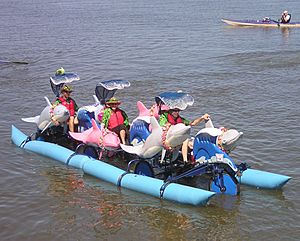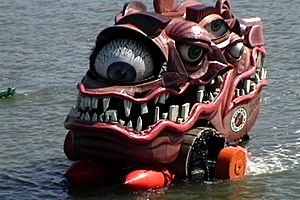Kinetic sculpture race facts for kids
Kinetic sculpture races are exciting contests where teams build amazing, all-terrain sculptures and then race them. It's like a "Triathlon of the Art World" because it mixes art, engineering, and physical challenge.
This three-day race covers over 50 miles and includes challenging terrains like sand, mud, paved roads, big hills, and even crossings over a bay and a river!
Contents
Kinetic Sculpture Races: Art, Engineering, and Fun!
Where Do These Amazing Races Happen?
Kinetic sculpture races are held in several fun locations across the United States:
- Humboldt County, California: This is home to the annual Kinetic Grand Championship. It's a three-day adventure covering about 42 miles (68 km) every May during the Memorial Day weekend.
- Baltimore, Maryland: The East Coast Championship, supported by the American Visionary Art Museum, covers about 15 miles (24 km) right through downtown Baltimore and its harbor.
- Gainesville, Florida: The Menagerie in Motion Kinetic Derby started in 2016. It's the only kinetic sculpture derby in the Southeast and happens every year in late February.
- Lowell, Massachusetts: New England's Lowell Kinetic Sculpture Race takes teams through city streets, a big mud pit, and even across the Merrimack River. This race happens on the third weekend of September.
- Other Locations: You can also find kinetic races in places like Port Townsend, Washington, Corvallis, Oregon, Ventura, California, Klamath Falls, Oregon, and Philadelphia, Pennsylvania.
The Story Behind the Races
The Original World Championship in California
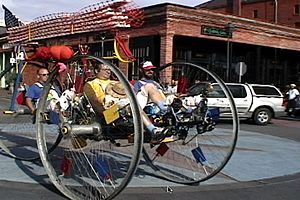
The idea for kinetic sculpture racing began in Ferndale, California, way back in 1969. A local artist named Hobart Brown decided to make his son's tricycle much more exciting. He added extra wheels and decorations, turning it into a wild "Pentacycle"! Another artist, Jack Mays, saw it and challenged Hobart to a race.
Soon, twelve unique machines were ready for the first race down Ferndale's Main Street. The winner wasn't Hobart or Jack, but Bob Brown, whose sculpture was a smoke-puffing turtle that laid eggs! Photos of a Congressman riding the Pentacycle even made the news across the country.
The race became an annual event. By the 1970s, it grew into a three-day, cross-country challenge. This is when it earned the nickname "Triathlon of the Art World." Sculptures had to conquer mud, sand, water, gravel, and pavement. Hobart Brown became known as the "Glorious Founder" of the race.
Over the years, the race grew with help from sponsors. A special "Kinetic Lab" was even created to help teams build amazing machines. One sculpture, the Yakima KingFish, was 92 feet (28 meters) long – the longest ever raced!
Hobart Brown's motto for the race was, "Adults having fun so children will want to grow older." As he got older, he sold the race rights to a non-profit group called the Humboldt Kinetic Association in 2002. Later, a new group, Kinetic Universe, took over in 2007 and changed the name to the Kinetic Grand Championship.
The 2014 World Championship race covered 42 miles (68 km). It crossed sand dunes, Humboldt Bay, and the Eel River. The race started in Arcata, went through Eureka and Loleta, and finished in Ferndale on the third day. Local radio station KHUM broadcast the race live.
Baltimore's East Coast Championship
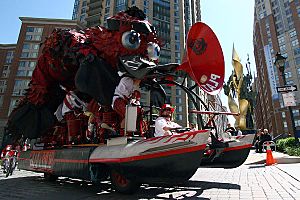
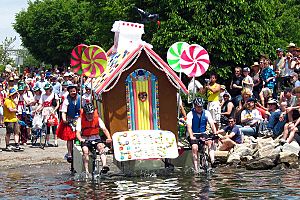
In 1999, the American Visionary Art Museum (AVAM) in Baltimore teamed up with Hobart Brown to start the first race on the East Coast. AVAM has sponsored this exciting race every year since!
For example, on May 4, 2019, 22 teams brought 25 sculptures to Baltimore for the 21st East Coast Championship. Due to health guidelines, the 2020 race was postponed, and the 2021 event was a "mini-race." The 22nd East Coast Championship took place on May 7, 2022, with twenty teams participating.
Unlike the rural California race, the Baltimore race is a one-day event right in the city. The 15-mile (24 km) course starts with a "Le Mans Start" down Federal Hill to AVAM. Racers pass famous landmarks like the Maryland Science Center and the National Aquarium. They enter the water at Canton, face sand and mud challenges at Patterson Park, and then race through downtown to the finish line back at AVAM. An awards ceremony celebrates the winners at the end of the day.
Meet the Rutabaga Queens!
A fun tradition in the Kinetic Grand Championship is choosing an annual Rutabaga Queen! These Queens are not just for show; they play an important role in the race. For example, the Queens from 2004, 2005, and 2006 helped create Kinetic Universe Inc., the non-profit group that now runs the Kinetic Grand Championship. Many former Queens continue to help organize the race.
Other kinetic races have their own special "Queens" too. For instance, Port Townsend, Washington, crowns a Rose-Hips Queen. In Australia, where they already have a real queen, they choose a Goddess to lead their festivities instead!
Kinetic Classic
A race for kids that mimics the adult one is held annually on the second Sunday of September. Children compete in categories based on age. Participants can decorate their bike, stroller or scooter with art. The distance of the race is about one quarter of a mile and features a small ramp, a sand crossing and water cannons to avoid.
See Also


